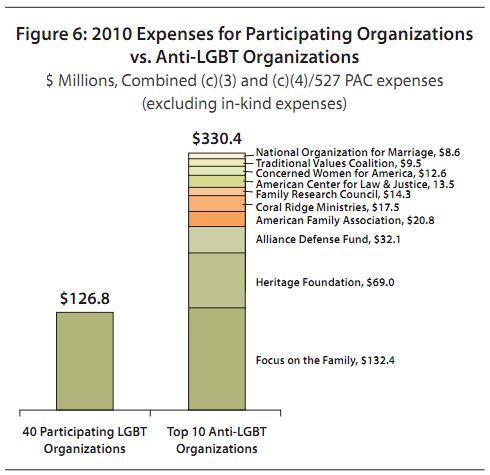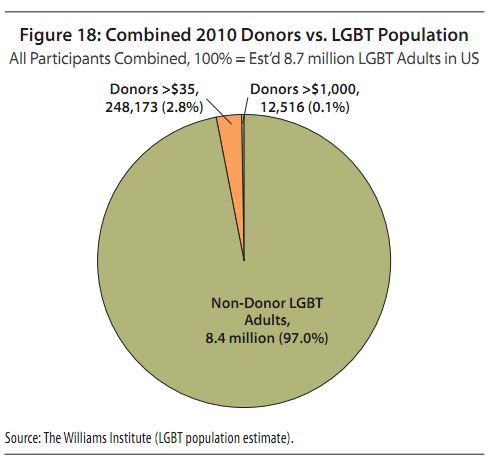The National LGBT Movement Report, which according to ThinkProgress‘s Zack Ford “analyzes the financial documents of 40 prominent LGBT organizations,” MAP estimates the number of individual donors to LGBT organizations only three percent of LGBT Americans.

The report estimates that most LGBT groups rely on just ten contributors for 45 percent of their annual income. The other 55 percent is made up of smaller donations. Ninety-seven percent of the estimated 8.7 million LGBT Americans decline to contribute to these organizations at all.
“There are many reasons for the relative dearth of donations coming from within our own community, but coming from the Midwest, I can tell you that many of our national organizations aren’t very well known in the interior of the country,” Interim Executive Director of Stonewall Democrats, Jerame Davis, told the Blade. “H.R.C., Stonewall Democrats, PFLAG, and Lambda Legal are the only organizations we heard from on a consistent basis in Indiana. Go ask your average Midwestern LGBT person to name even five national LGBT organizations; something tells me they wouldn’t get past number three.”
More alarming is that the ten largest openly anti-LGBT groups spend almost three times as much annually as all 40 of the LGBT groups measured; at $330.4 million versus the $126.8 million spent collectively. Multi-issue anti-LGBT organizations such as Focus on the Family, Heritage Foundation and Alliance Defense Fund had budgets dwarfing most LGBT organizations, assisted by smaller but more focused organizations like National Organization for Marriage, Family Research Council and the Traditional Values Coalition.
ThinkProgress adds that many of the donors to LGBT organizations are actually straight allies, which may mean that the number of LGBT Americans contributing to these organizations is actually lower than the estimate in the MAP report.

The report surveyed 40 of the most prominent LGBT organizations in the nation
from the Human Rights Campaign, the National Gay & Lesbian Task Force, and
Victory Fund, Gay and Lesbian Alliance Against Defamation, and National Center
for Lesbian Rights to smaller organizations like Log Cabin Republicans,
SoulForce, the Trevor Project, and In The Life Media, and even some state-wide
and local organizations like Empire State Pride Agenda, Equality California, and
the New York City Gay & Lesbian Anti-Violence Project.
According to the report, Focus on the Family on its own out fund-raised all 40 LGBT organizations collectively.
Stonewall’s Davis believes that if organizations invested more time in creating a presence in ‘middle America,’ LGBT donors may be more willing to contribute.
“It has been a regular complaint from those in ‘flyover country’ that the national LGBT movement needs to focus more on the very clear and obvious lack of equilibrium in equality around the country,” Davis told the Blade. “The stark imbalance when you look at a state like Indiana vs. a state like New York makes it hard for folks in those states with less equality to believe the national movement is working for them. That turns off a lot of potential donors who are motivated to give, but feel they have few outlets to do so that will directly impact their daily lives.”
Some good news reported by MAP, however, is that most of the 40 organizations studied have turned their finances around from a 2009 low, with revenue exceeding expenses this year — contrasting with 2009 when expenses outpaced revenue — and most LGBT organizations report a general increase in revenue coupled with a general decrease in expenses.
According to the report, Focus on the Family on its own out fund-raised all 40 LGBT organizations collectively.
Stonewall’s Davis believes that if organizations invested more time in creating a presence in ‘middle America,’ LGBT donors may be more willing to contribute.
“It has been a regular complaint from those in ‘flyover country’ that the national LGBT movement needs to focus more on the very clear and obvious lack of equilibrium in equality around the country,” Davis told the Blade. “The stark imbalance when you look at a state like Indiana vs. a state like New York makes it hard for folks in those states with less equality to believe the national movement is working for them. That turns off a lot of potential donors who are motivated to give, but feel they have few outlets to do so that will directly impact their daily lives.”
Some good news reported by MAP, however, is that most of the 40 organizations studied have turned their finances around from a 2009 low, with revenue exceeding expenses this year — contrasting with 2009 when expenses outpaced revenue — and most LGBT organizations report a general increase in revenue coupled with a general decrease in expenses.
LGBT organizations have also kept control of the cost of
fundraising with only 11 percent annual expenses on average going toward
fundraising at the 40 largest LGBT organizations, and the other 89 percent of
expenses being split between programs & services (79 percent) and operations
(ten percent).

No comments:
Post a Comment